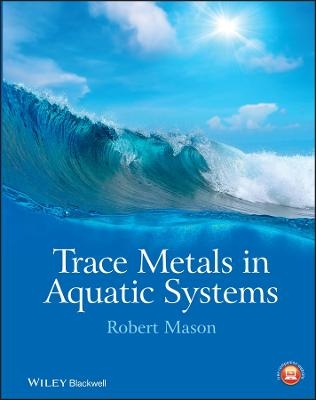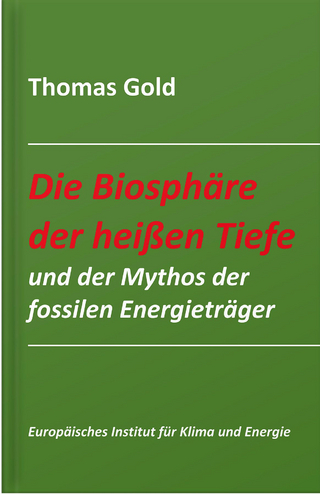
Trace Metals in Aquatic Systems
Wiley-Blackwell (Verlag)
978-1-4051-6048-3 (ISBN)
- Titel z.Zt. nicht lieferbar
- Versandkostenfrei innerhalb Deutschlands
- Auch auf Rechnung
- Verfügbarkeit in der Filiale vor Ort prüfen
- Artikel merken
Specific examples deal with metals that are of particular scientific interest, such as mercury, iron, arsenic and zinc, and the book deals with both pollutant and required (nutrient) metals and metalloids. The underlying chemical principles controlling toxicity and bioavailability of these elements to microorganisms and to the aquatic food chain are also discussed.
Readership: Graduate students studying environmental chemistry and related topics, as well as scientists and managers interested in the cycling of trace substances in aqueous systems
Additional resources for this book can be found at: www.wiley.com/go/mason/tracemetals.
Robert Mason is a Professor in the Departments of Marine Sciences and Chemistry at the University of Connecticut. His research focuses on the chemistry, fate, transport and bioaccumulation of trace metals in the marine and freshwater environments, with a focus on exchanges at the primary interfaces (air/water and sediment/water) and on transformations (methylation/demethylation, oxidation/reduction). Mercury biogeochemistry has been the primary focus of much of his research.
Preface, ix
About the companion website, x
1 Introduction, 1
1.1 A historical background to metal aquatic chemistry, 1
1.2 Historical problems with metal measurements in environmental media, 5
1.3 Recent advances in aquatic metal analysis, 9
References, 10
Problems, 12
2 An introduction to the cycling of metals in the biosphere, 13
2.1 The hydrologic cycle, 13
2.2 An introduction to the global cycling of trace metal(loid)s, 15
2.2.1 The sources and cycling of metal(loid)s in the biosphere, 15
2.2.2 Metal(loid) partitioning and solubility in natural waters, 16
2.2.3 Human infl uence over metal(loid) fate and transport, 19
2.2.4 Trace metal(loid) inputs to the atmosphere, 25
2.2.5 Metal(loid)s in the terrestrial environment and freshwater ecosystems, 26
2.2.6 The transport of metal(loid)s to the ocean, 30
2.2.7 Trace metal(loid)s in ocean waters, 33
2.2.8 Trace metal(loid) inputs from hydrothermal vents, 36
2.3 Global cycles of some important trace metals, 38
2.3.1 The global cycles of cadmium, copper, and zinc, 39
2.3.2 The global cycle of mercury and lead, 41
2.4 Chapter summary, 44
References, 44
Problems, 47
3 Chemical thermodynamics and metal(loid) complexation in natural waters, 49
3.1 Thermodynamic background for understanding trace metal(loid) complexation, 49
3.1.1 The relationship between free energy and the equilibrium constant, 51
3.1.2 Ionic strength effects, 52
3.1.3 Thermodynamic equilibrium, kinetics and steady state, 54
3.2 Bonding, electronic confi guration, and complex formation, 55
3.2.1 Ligand Field Theory, 58
3.2.2 Thermodynamic effects of orbital splitting, 61
3.2.3 Inorganic chemistry and complexation of transition metals, 62
3.2.4 Inorganic chemistry and complexation of non-transition metals and metalloids, 65
3.3 Complexation of metals in solution, 67
3.3.1 Inorganic complexation, 67
3.3.2 An approach to determining metal(loid) speciation in solution, 68
3.3.3 The chemistry and speciation of metal-binding ligands, 72
3.3.4 The complexation of the major ions in solution, 77
3.3.5 Metal complexation with low molecular weight organic ligands, 79
3.3.6 Complexation to large molecular weight organic matter, 81
3.4 Trace metal interactions with the solid phase, 86
3.4.1 Precipitation and dissolution, 86
3.4.2 Adsorption of metals to aqueous solids, 90
3.4.3 Dissolved-particulate partition coeffi cients, 91
3.4.4 Adsorption isotherms, 92
3.4.5 A complexation-based model for adsorption, 93
3.5 Redox transformations and thermodynamic calculations, 102
3.5.1 Electrochemistry and the equilibrium constant, 102
3.5.2 The range in electrode potential and the stability of water, 104
3.5.3 Equilibrium calculations involving redox reactions, 105
3.5.4 Environmental considerations and controlling reactions, 108
3.6 Chapter summary, 112
Appendix 3.1, 114
References, 120
Problems, 121
4 Modeling approaches to estimating speciation and interactions in aqueous systems, 123
4.1 Introduction, 123
4.2 The underlying basis and application of chemical equilibrium models, 126
4.3 Adsorption modeling, 131
4.4 Modeling interactions between cations and organic matter, and inorganic surfaces, 144
4.4.1 The WHAM modeling approach, 144
4.4.2 The NICA-Donnan modeling framework, 149
4.4.3 Modeling the adsorption of humic acids to surfaces and the interaction with metal(loid)s, 151
4.5 Modeling redox transformations, 152
4.6 Modeling the kinetics of reactions, 155
4.6.1 Reactions in solution, 155
4.6.2 Adsorption/desorption kinetics, 160
4.6.3 Uptake kinetics for microorganisms, 160
4.7 Incorporating kinetics and thermodynamics into fate and transport modeling, 161
4.8 Chapter summary, 162
Appendix 4.1, 162
Appendix 4.1a, 162
Appendix 4.1b, 163
References, 163
Problems, 165
5 Metal(loid)s in the atmosphere and their inputs to surface waters, 167
5.1 Introduction, 167
5.2 Atmospheric transport and deposition, 167
5.2.1 Dry deposition, 167
5.2.2 Aerosol distributions and metal(loid) concentrations, 172
5.2.3 Wet deposition, 177
5.2.4 Atmospheric deposition fl uxes, 181
5.2.5 Source apportionment of atmospheric metal(loid)s, 185
5.2.6 Gaseous volatilization and gas exchange of metal(loid) compounds, 189
5.3 Atmospheric chemistry and surface water photochemistry of metals, 194
5.4 Solubilization of aerosol metal(loid)s in natural waters, 198
5.5 Focus topics, 200
5.5.1 Focus topic: Atmospheric inputs and atmospheric chemistry of iron, 200
5.5.2 Atmospheric chemistry and air–water exchange of mercury, 202
5.6 Inputs of atmospheric metals to the biosphere, 206
5.7 Chapter summary, 209
References, 209
Problems, 217
6 Trace metal(loid)s in marine waters, 219
6.1 Introduction, 219
6.2 Metal(loid) partitioning in coastal and open ocean waters, 221
6.2.1 The mechanisms of partitioning, 221
6.2.2 Examination of metal speciation in the particulate phase, 227
6.2.3 Examination of the complexation of metals with natural ligands in the filtered fraction, 232
6.2.4 Metal concentrations in coastal waters, 237
6.3 Metals in coastal and offshore sediments, 238
6.3.1 Metals in the bulk phase, 238
6.3.2 Metals in sediment porewater, 243
6.3.3 Modeling metal cycling in sediments, 249
6.3.4 Modeling of metal speciation in marine sediment porewaters, 255
6.3.5 The importance of sediment resuspension and extreme events in coastal metal dynamics, 259
6.3.6 Deep ocean sediments and manganese nodules and accretions, 264
6.3.7 The biogeochemistry of metals in hydrothermal systems, 267
6.4 Metal distributions in open ocean waters, 270
6.4.1 Vertical distribution of metal(loid)s and controlling factors, 270
6.4.2 Coordinated ocean studies: GEOTRACERS and prior and related programs, 275
6.4.3 Iron, manganese, and aluminum cycling in open ocean waters, 279
6.4.4 The biogeochemical cycling of zinc and cadmium in the ocean, 280
6.4.5 Copper, cobalt, and other nutrient transition metals in the oceans, 282
6.4.6 Anthropogenic metals – lead, silver, and mercury, 283
6.4.7 Metalloids and other oxyanion cycling in seawater, 290
6.4.8 Other transition metals, the lanthanides, and actinides, 292
6.4.9 Particulate metal fl uxes to the deep ocean, 294
6.5 Chapter summary, 297
References, 298
Problems, 307
7 Trace metals in freshwaters, 310
7.1 Overview of metal cycling in freshwaters, 310
7.2 Trace element cycling in lakes, 313
7.2.1 Processes infl uencing metal(loid) fate and dissolved speciation in lakes, 314
7.2.2 Modeling the speciation and association of trace elements in stratified systems, 327
7.2.3 Focus topic: Mercury cycling in lakes, 330
7.3 Trace elements in rivers and groundwater, 336
7.3.1 Trace elements in rivers, 336
7.3.2 Trace elements in groundwater, 345
7.3.3 Focus topic: Mining impacts and acid mine drainage, 348
7.3.4 Arsenic in surface water and groundwater, 350
7.3.5 Metal inputs from groundwater and margin exchange processes, 354
7.4 Human activities and their impact on trace metal(loid) concentrations in drinking water and receiving waters, 356
7.4.1 Lead in drinking water, 357
7.4.2 Metal inputs from waste water treatment facilities and other industrial discharges, 358
7.5 Metal stable isotopes and their use, 360
7.6 Chapter summary, 363
References, 364
Problems, 368
8 Trace metals and organisms: Essential and toxic metals, organometallics, microbial processes, and metal bioaccumulation, 370
8.1 Introduction, 370
8.2 Mechanisms of metal accumulation by microorganisms, 372
8.2.1 The transport of metals across membranes, 372
8.2.2 Passive transport (diffusion), 373
8.2.3 Facilitated transport (accelerated diffusion), 377
8.2.4 Active uptake, 380
8.3 Essential trace metals, 381
8.3.1 An overview of essential trace metals, 381
8.3.2 Focus topic: Iron uptake by microbes in marine waters, 383
8.3.3 Focus topic: Transition metals and carbon fi xation by microbes, 388
8.3.4 The biochemistry of metals and their presence in the early biosphere, 391
8.4 Organometallic compounds and microbial transformations of metals, 393
8.4.1 Mechanisms of metal methylation, 393
8.4.2 Less common organometallic compounds, 397
8.4.3 Alkylated mercury compounds, 399
8.4.4 Lead and tin compounds, 402
8.4.5 Organometallics of arsenic, antimony, and bismuth, 404
8.5 Bioavailability and bioaccumulation, 406
8.5.1 Introduction, 406
8.5.2 Trophic transfer of metals, 408
8.5.3 Exposure and bioaccumulation models, 410
8.6 Chapter Summary, 414
References, 415
Problems, 421
Index, 422
| Erscheint lt. Verlag | 19.4.2013 |
|---|---|
| Verlagsort | Hoboken |
| Sprache | englisch |
| Maße | 218 x 279 mm |
| Gewicht | 1315 g |
| Themenwelt | Kunst / Musik / Theater ► Theater / Ballett |
| Naturwissenschaften ► Biologie ► Biochemie | |
| Naturwissenschaften ► Biologie ► Limnologie / Meeresbiologie | |
| Naturwissenschaften ► Biologie ► Ökologie / Naturschutz | |
| Naturwissenschaften ► Chemie | |
| ISBN-10 | 1-4051-6048-9 / 1405160489 |
| ISBN-13 | 978-1-4051-6048-3 / 9781405160483 |
| Zustand | Neuware |
| Haben Sie eine Frage zum Produkt? |
aus dem Bereich


